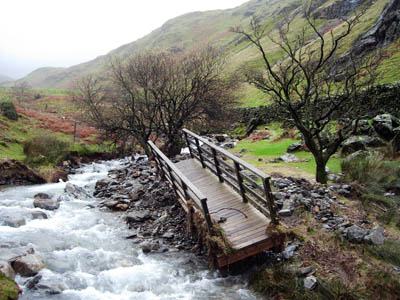
This bridge, at Squat Beck, near Whiteless Pike, Buttermere, was one of many damaged during the floods
A major restoration scheme has been agreed to repair damage to footpaths and bridges devastated in the Lake District’s worst ever floods last year.
The deluge in November 2009 caused £1.7m-worth of damage to rights of way in the national park and a further £1.5m in the rest of Cumbria.
The county has the second largest system of rights of way in England – equivalent to Cumbria’s whole road network, and a £3.2m plan has been drawn up to replace or repair the 253 bridges and 85 paths destroyed or damaged in the floods.
The four-year plan, devised by the Lake District National Park Authority and Cumbria County Council, will include widespread repair and reconstruction, replacing gates, stiles and signs in a county which has 7,500km of footpaths, bridleways and byways.
The Rural Development Programme for England and the Department for the Environment, Food and Rural Affairs are funding the first £1.3m restoration phase.
LDNP’s new paths for the public co-ordinator Dylan Jackman, a former national park field worker, said priority had been given to making sure residents were able to get on with their lives and there was minimal impact on the local economy and tourist industry.
He added: “An enormous amount of work has gone into surveying the damage and we are very grateful that external funding is now allowing us to get to grips with this difficult and costly operation.
“We are also determined to carry out the work in ways that will lessen the effects of future extreme weather. In particular, we will be looking at methods which will give us some flood resilience.
“Part of this process includes working with our key partners, including Natural England, the Environment Agency, National Trust, Forestry Commission and North West Development Agency.”
Mr Jackman said there was total commitment to getting the work done as quickly as possible, while maintaining the highest standards.
“Wherever possible, we will be using local materials and contractors, when needed,” he said. “We know there is urgency from both residents and visitors to restore the rights of way that form a vital part of our world renowned landscape.”
Work is expected to be completed in 2013.